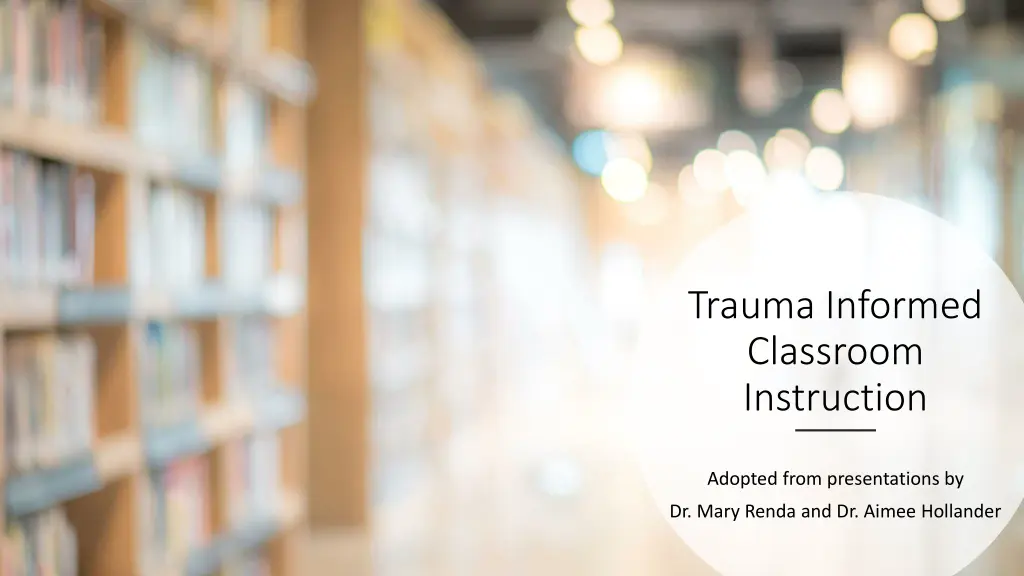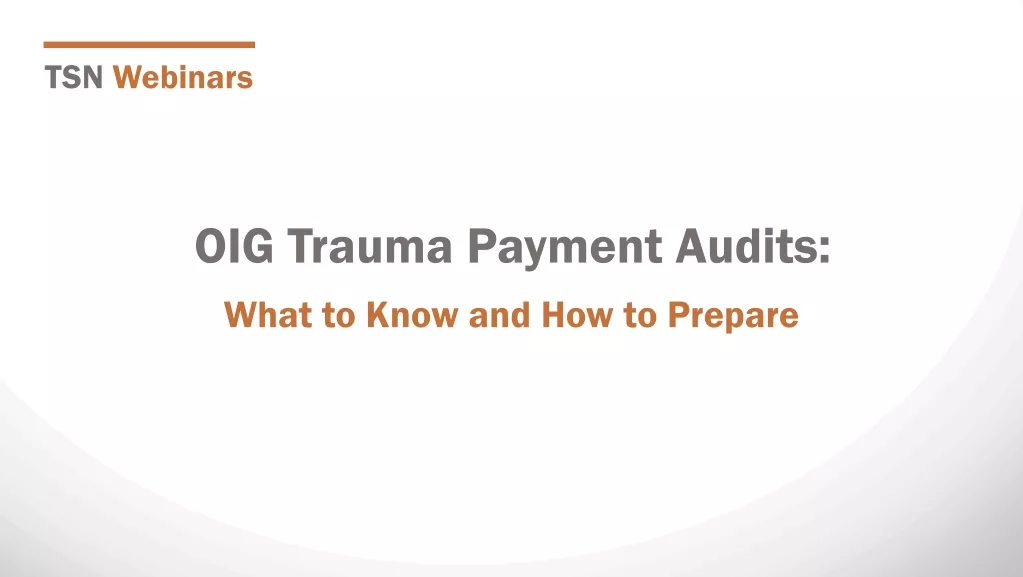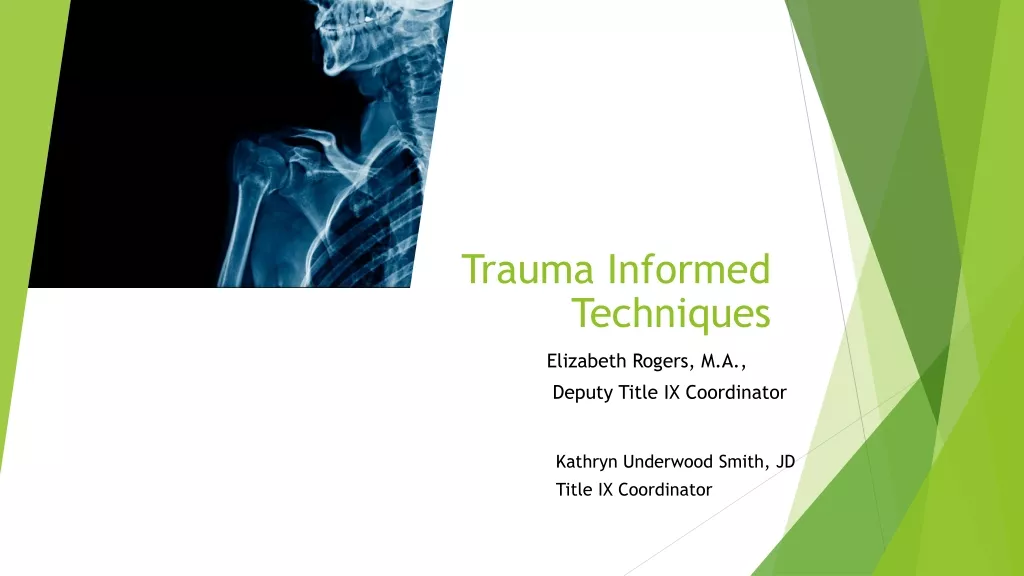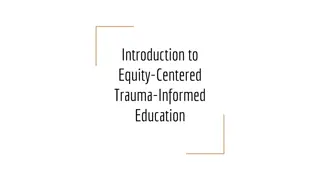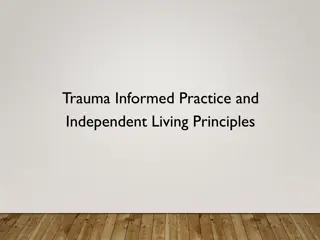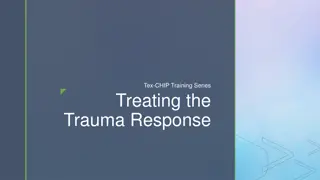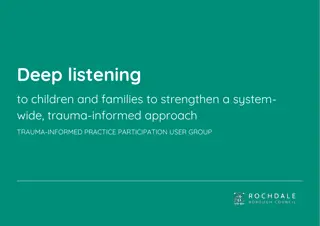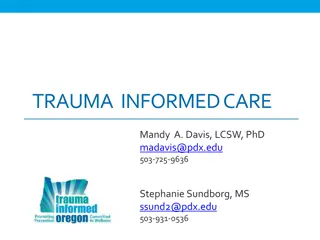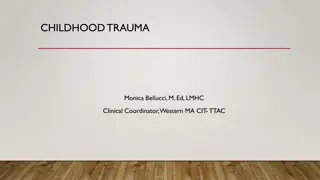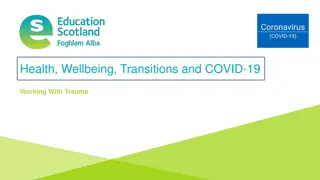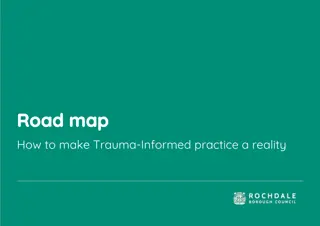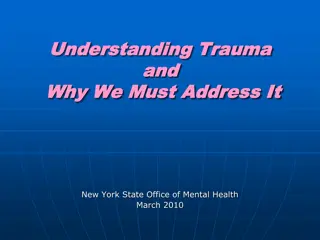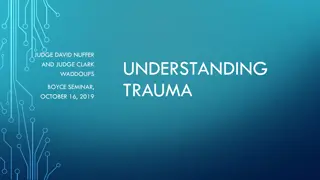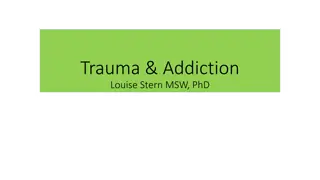Trauma Informed Classroom Instruction
Explore trauma responses and practices for engaging with students. Provide content warnings, foster community, offer flexibility in assessments.
Download Presentation

Please find below an Image/Link to download the presentation.
The content on the website is provided AS IS for your information and personal use only. It may not be sold, licensed, or shared on other websites without obtaining consent from the author.If you encounter any issues during the download, it is possible that the publisher has removed the file from their server.
You are allowed to download the files provided on this website for personal or commercial use, subject to the condition that they are used lawfully. All files are the property of their respective owners.
The content on the website is provided AS IS for your information and personal use only. It may not be sold, licensed, or shared on other websites without obtaining consent from the author.
E N D
Presentation Transcript
Trauma Informed Classroom Instruction Adopted from presentations by Dr. Mary Renda and Dr. Aimee Hollander
Elizabeth Blankenship (University of New Orleans) Your Presenters Meredith King (University of New Orleans)
Where Y'at?! What is trauma-informed classroom instruction Today s presentation Principles and examples Grounding and settling practices for us and our students Do s and don ts of engaging with others during a trauma response
Grounding exercise Where Y at?! How is everyone doing?
What is trauma-informed classroom instruction? Trauma is not an event itself, but the body's protective response to an event or series of events that is experienced as harmful or life-threatening. It can have lasting emotional and physical effects on an individual. Importantly, trauma is not experienced the same by everyone. A traumatic event for one individual may or may not prompt a trauma response in another, even if the experiences seem similar. Everyone's response is unique and independent of those around them.
What is trauma-informed classroom instruction? Providing content information in advance Trauma-informed pedagogy is pedagogical practice that keeps trauma, its prevalence, and how it affects an individual, in mind. These include practices such as: Using content descriptions, especially for potentially triggering media Creating a safe and inclusive framework for discussions Checking in on students Encouraging community building and sense of belonging Allowing for multiple ways to engage with course content Building flexibility into assessment and absence policies Valuing student input and feedback
Principles and Examples Discussed Today Empowerment and Co- Creation Predictability and Transparency Connection and Community Belonging and Inclusion Flexibility and Multiple Alternatives
Provide information about content in advance of class meetings (course schedule or syllabus with topics). PREDICTABILITY AND TRANSPARENCY: Use content descriptions and warnings for readings that are potentially triggering. State what content and interactive elements will be included at the start of a class session. Use a routine or consistent structure for how classes are facilitated. Predictability and transparency can create a sense of safety for students who have experienced trauma and feel a loss of control over what could happen to them. If introducing a new facilitation or participation structure, give detailed instructions, expectations, and an example of how the structure will work. Use rubrics to clearly state instructor expectations for assignments, participation, etc. Provide concrete options for how students can take care of themselves if they feel triggered by a topic or conversations (mute your video, send me a private chat, take a break, do a breathing exercise, get a drink of water, take a walk outside, etc.).
Connection and Community Building community is important for increasing students capacity for social engagement after trauma causes feelings of disconnection and isolation. Examples Explicitly talk about the importance of community building, learning from each other, and supporting each other within your class. Begin class with asking students about how they are doing, how their week has been going, or with a temperature check about their mood (discussion question, anonymous poll, etc.). Approach questions or concerns from a class/community perspective For example - How do we as a class want to address this? What does this mean for us as a community? How can we all support each other through this? Encourage students to build connections with each other through forming study groups, sharing support resources, and checking in on each other.
Flexibility and Multiple Alternatives An individual s body can respond in unpredictable ways to keep them safe during a trauma response. Instructors need to be flexible to meet students needs in order to resist re- traumatization. Examples Provide options for different ways of engaging with material, especially if a topic may be triggering. For example, offer students the option of choose between different breakout groups that will focus on a specific aspect of the topic different perspectives of a topic Provide options for different ways of engaging with material, especially if a topic may be triggering. For example, for a class topic on childhood abuse, you can provide students with the option of doing a written assignment on a variety of related topics Provide various ways to engage in the topic quizzes, short answer, different type of assignments that meet the objective
Flexibility and Multiple Alternatives Cont. Provide options for projects or assignments on topics that may be triggering Rather than only providing one topic for an essay assignment, provide options for several topics so that students can choose a topic that feels most feasible for them to address without experiencing re-traumatization. Offer a certain amount of quizzes or assignments that can be dropped and offer a certain amount of days that students can be absent without needing a justification. Encourage students to contact you about accommodations and give some examples of accommodations you feel comfortable offering.
Belonging and Inclusion Intentionally cultivating a classroom where students feel included can lower the students perceptions of danger and increase capacity for engagement and learning. Examples Use students properly pronounced names and pronouns (this can be entered in zoom by clicking re-name by your name). Explicitly acknowledge your intention to create an inclusive classroom environment and include a class agreement that acknowledges oppression.
Belonging and Inclusion Cont. Assume your students have been affected by the topics that come up during class. Resist making statements that would make a student feel alienated for their experience. For example, if you are talking about the rate of attempted suicide in the United States, assume that someone within your class has attempted suicide and do not make generalized statements like People who attempt suicide have fewer social support systems. Challenge statements or generalizations that could be harmful to students. Talk about mistakes as an essential part of the learning process and challenges as being necessary for success. Acknowledge any mistakes you might make as an instructor, stress your commitment to taking your students concerns seriously, and explain your concrete steps to create an environment that intentionally includes and values them. Recognize how equity issues are woven into the experience of trauma: when a person from a marginalized group experiences trauma, the same conditions that marginalize them may limit their access to resources (Venet).
Empowerment and Co-Creation When experiencing trauma, individuals often lose the ability to make decisions to protect themselves. By valuing students as co-creators in the classroom, instructors can contribute to students building trust in their abilities, knowledge, and contributions. Examples Explicitly state the value of students knowledge, insights, and expertise within the course. Ask students about their preferences around topics, participation, and assignments through an individual form and/or through a class discussion. Encourage students to notice what they need in order to take care of themselves and be successful in their learning, express their needs, and meet their needs. Ask students about their knowledge of a topic before introducing it so that they can share their insights about what they already know. Provide frequent opportunities for student feedback about how the class is going and students experiences with the material and the course structure (mid-term survey)
Grounding / Settling Practices: BREATHING Box breath - trace a box in your mind as you inhale to a count of 4, exhale to a count of 4, inhale to a count of 4, and then exhale to a count of 4 Inhale and exhale as you trace the outline of your fingers, inhale while moving up a finger, exhale while moving down Breathe in and out of your belly
Hum in a low tone Grounding/Settling Practices: VOCAL PRACTICES Buzz like a bee, experimenting with different tones Sing or hum a song
Grounding/Settling Practices: IMAGINATION AND MOVEMENT Think about a time when you felt loved/happy. Notice what happens in your body Think about a place in nature that you like to be. Recall it into mind with your 5 senses. Move around your space. Tense and relax a part of your body. Stretch your arms, then your legs.
Demonstrate and communicate calmness Listen nonjudgmentally Empathize with how the person feels about their experiences Be patient, allow plenty of time Offer reflective comments about what they are saying Do s: Things to do in the moment Provide different options rather than offering one choice Communicate your presence and support Ask consent before providing resources Sample language: Thank you so much for sharing that with me. Please do whatever is good for you right now, I ll just be here. That must be frustrating. It makes sense for you to have that reaction. I appreciate you being willing to share that. Would you like to turn off the video and mute yourself for a little or would you like to stay connected?
Make Make decisions that remove their control Rush Rush to make assessments or give them resources Don ts: Things not to do in the moment Use Use shame or threats Use Use patronizing statements Touch Touch someone Act Act alarmed, horrified, embarrassed Use Use sarcasm
Check in with yourself and what you need to do in order to settle yourself and address any of the tension or emotions you might be feeling Afterwards
